Saad Iqbal | 🗓️Modified: January 1, 2018 | ⏳Read Time: 5 min | 👁Post Views: 961
Ordinary Portland Cement: – OPC is produced by finely grinding OPC clinker obtained from the cement kilns.
This cement on hydration produces C-S-H gel (Calcium – Silicate – Hydrate) Gel, which provides cementation property and is the primarily responsible for strength is cement products. Along with C-S-H gel
it also produces Ca(OH)2, which does not provide any strength, rather it causes further problems of leaching in concrete.
 |
| difference between ordinary portland cement and portland pozzolana cement |
It may be noted that leaching or
efflorescence in concrete happens when lime compounds, as mentioned above, leads to the formation of salt deposits on the
surface of concrete which leads to increased porosity and further enhanced deterioration.
This usually happens near cracks where pure water can circulate easily.
Portland Pozzolana Cement
PPC is produced by inter-grinding OPC clinker along with some pozzolanic material like fly ash (FA). This cement also produces on hydration, C-S-H gel along with Ca(OH)2, which further reacts with the pozzolanic material to produce more amount of C-S-H gel, which provides additional cementation and thus increases the overall strength and reduces Ca(OH)2 content.
Pozzolanic materials have siliceous or siliceous and aluminous components that when finely grinded and mixed with water reacts chemically with lime to produce compounds possessing cementations properties.
The pozzolanic materials are used as supplementary cementations materials.
One of the widely used pozzolanic material is fly ash (FA). Fly ashes are mostly obtained from coal-fired electric power plants. Coal based thermal power plants have been a major source of Power Generation in India where almost 75% of the total power obtained is from coal based
thermal power plants. So resultantly huge amount of its by-product fly ash is obtained which was in the past dumped in lagoons, land fill sites and abandoned quarries.
In the concrete mix reduction of 40% of Portland cement is usually feasible when replaced with pozzolanic materials.
Thus, these Pozzolanic Portland Cement have more control on setting time with increased durability. Moreover, cost and pollution are significantly reduced without affecting the final compressive strength
characteristics of the Concrete mix.
In Portland Pozzolana cement (PPC) Fly ash or pozzolanic material is added to clinker but recently a new trend is introduced to process Fly Ash by blending it with ordinary Portland cement. Fly ash which is sometimes named as Pulverized Fuel Ash with compositions of fine particles of fuel that are driven out of coal-fired boilers.
One of a significant benefit obtained by the use of flyash material is increased workability which allows the concrete to be used in pumps easily without causing any problems of cracking, permeability and bleeding. With the use of Pozzolanic material the quantity required of cement is reduced which eventually will reduce the amount of Co2 emissions making it more sustainable and environmentally friendly.
Although the Portland Pozzolana Cement have tremendous advantages over Ordinary Portland Cement but there are certain limitations as well.
The Portland Pozzolana Cement have major concerns about freeze/thaw performance. Which may need more
air entraining admixtures to be added which might increase the overall cost. The seasonal variations and increased salt scaling are another thing one must be careful about.
Portland Slag Cement:- PSC is obtained by mixing Portland cement clinker, gypsum and granulated blast furnace slag in suitable proportions and grinding the mixture to get a thorough and intimate mixture between the constituents. The resultant product is cement which has physical properties similar to OPC. It has low heat of hydration and is relatively better resistant to chlorides and hence can be used for marine works. Due to the use of Slag in Portland Cement the unit volume is reduced making produced concrete less vulnerable to
alkali-silica reaction and
sulfate attack.
Slag is actually a by-product that is obtained during combustion processes on metals either for their smelting, welding or for other metallurgical operations. Slag is physically similar in looks to a volcanic rock or a basalt or granite rock.
I am currently working on a Dam Project in South Asia region and here we are using Sharja Slag which is a product of Sharja Cement and Industrial Development Company. The Shrja slag is a ground granulated Blast Furnace slag.
This material is produced by grinding dried Granulated Slag in a closed circuit milling system to a surface area of ~380m2/kg. This Granulated Slag is the same material used to produce Blastfurnace cement.
So, In this article you have learnt that what is ordinary portland cement, How it is produced. What is pozzolanic materials? how pozzolans are produced? What is the use of these materials in cement? What is slag and how it is used in cement to enhance the properties and sustainability of Cement mix.


